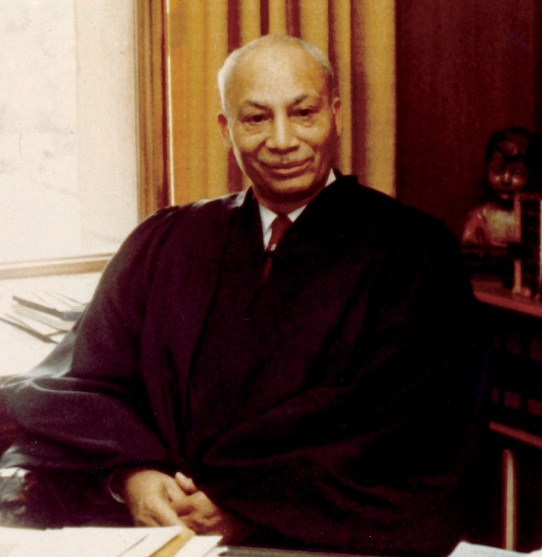Judge Harold A. Stevens was the first African-American to serve on the New York Court of Appeals. But this milestone, achieved in 1974, was only one of many trail-blazing “firsts” in the extraordinary life of this exceptional lawyer and jurist. Judge Stevens was also the first African-American to graduate from Boston College Law School in 1936; the first elected to the Court of General Sessions in 1950; the first appointed and then elected to the New York State Supreme Court; the first to serve on the Appellate Division (appointed 1958) and the first African-American Presiding Justice of the Appellate Division (appointed 1969). Born and raised in the South during segregation, Judge Stevens settled in New York, a state he served as an advocate, a legislator and a judge. We honor that service and pay tribute to Judge Stevens during Black History Month.
His Tenure on the Court of Appeals
Judge Stevens arrived on the Court of Appeals during a time of significant change for the Court. Court of Appeals judges were elected, although this method of selection had become controversial.
Between November 1972 and November 1974, there were no less than six Court of Appeals Judgeships to be decided by popular vote. In 1972 alone, three new members were elected to the Court (Domenick Gabrielli, Hugh Jones and Sol Wachtler). Judge Stevens joined the Court in the aftermath of a closely-contested election for the position of Chief Judge between then-Associate Judge Charles Breitel and private practitioner Jacob Fuchsberg in November 1973. Judge Breitel won the election but the hard-fought race caused many to call for change from an elective to an appointive system.[1]
The elevation of Judge Breitel to Chief Judge left an Associate Judge vacancy. A second vacancy occurred at the same time due to the resignation of Judge Adrian Burke. In January 1974, pursuant to Article 6, § 2(b) of the New York Constitution, Governor Malcolm Wilson appointed then-Presiding Justice Stevens of the First Department and Presiding Justice Samuel Rabin of the Second Department to fill the two one-year vacancies. To serve a full term, however, Judge Stevens would have to run for election in November.[2]
Judge Stevens secured the support of each of the four major political parties and, as late as June 1974, he was believed to be well on his way to victory in the general election. It was not to be. In July 1974, Jacob Fuchsberg circulated nominating petitions seeking a spot in the Democratic Party primary for the Court of Appeals seat. Because two vacancies existed on the Court, each party nominated two individuals for the Judgeships. The Democratic Party nominated Judge Stevens and Justice Lawrence Cooke, then sitting on the Appellate Division, Third Department. Judge Stevens and Justice Cooke received substantial support from the New York State Bar Association and other bar groups. However, Judge Fuchsberg had an organized, well-funded campaign and name recognition based on the television and radio advertisements he had run the previous year in his unsuccessful race for the position of Chief Judge.
Jacob Fuchsberg and Justice Cooke won the Democratic primary with Judge Stevens finishing a close third. Thus, in the general election, Judge Stevens, a life-long Democrat, ran on the Republican, Liberal and Conservative party lines. In the general election, Justice Cooke garnered the most votes with Judge Fuchsberg narrowly defeating Judge Stevens for the second vacancy.
Deeply disappointed over Judge Stevens’ defeat, bar leaders redoubled their efforts to change the selection process for Court of Appeals Judges, calling on Governor Carey to lead the effort. In 1976 and 1977, two successive Legislatures passed the necessary laws to present constitutional amendments to the voters that would authorize gubernatorial appointment of Court of Appeals Judges with the advice and consent of the Senate. The voters approved the proposed constitutional changes in the 1977 election.
Although he served on the New York Court of Appeals for only one year, Judge Stevens left a lasting impression on its jurisprudence, most notably authoring Matter of Pell v. Board of Educ. of Union Free School Dist. No. 1 of the Towns of Scarsdale and Mamaroneck, Westchester County (34 NY2d 222 [1974]). Pell — clarifying the scope of review in cases involving challenges to administrative determinations — is among the best-known decisions ever issued in the area of New York Administrative Law, having been cited more than 3000 times.[3]
On January 1, 1975, Judge Stevens returned to the Appellate Division. Soon thereafter, newly-elected Governor Carey reappointed Judge Stevens to his position as Presiding Justice of the First Department, where he served until his retirement.
Judge Stevens died of a heart attack in 1990 at the age of 83. Chief Judge Wachtler, who served with Judge Stevens in 1974, delivered a Memoriam at the opening of the Court on November 13, 1990, in which he observed:
“Harold Stevens brought warmth and humor to this Court, and these are qualities that all of us who knew and respected him will always remember fondly. More importantly, however, Harold also possessed a deep understanding of the human condition, an understanding which found its way into his decisions. He knew from first-hand experience the cruelty of persecution and prejudice, and he brought this insight and this dimension to his role as Judge.”

